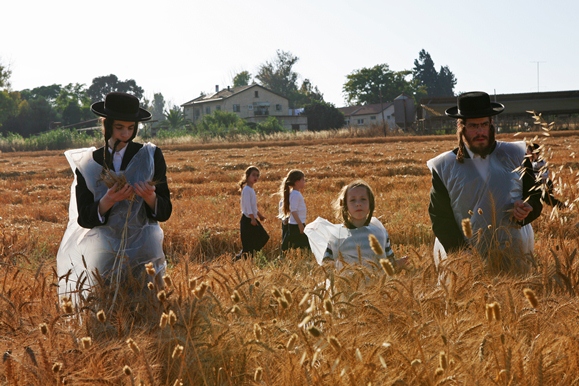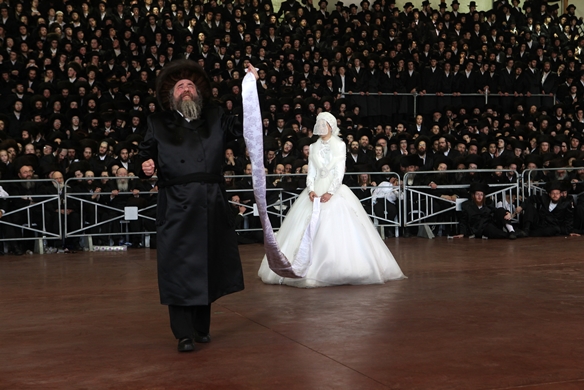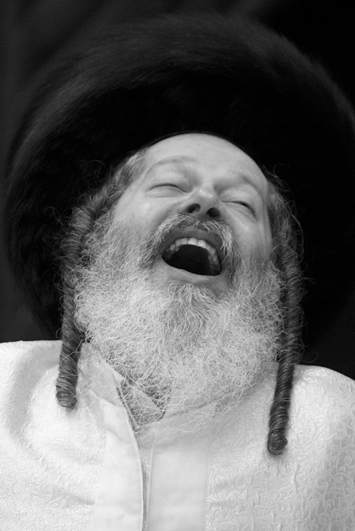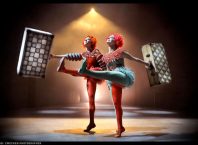Although the Second Commandment “Thou shalt not make graven images” (Exodus 20:4) may forbid Hasidim from visiting the Israel Museum, it certainly did not stop the recently opened A World Apart Next Door exhibit from visiting the lives of Hasidic Jews and displaying the findings for one and all to see. A World Apart Next Door: Glimpses into the Life of Hasidic Jews unveils an extraordinary display, offering a rare opportunity for the non-Hasidim to take a peek into what Hasidic life – otherwise unknown to, and segregated from, the modern world – is all about. The exhibit enables its visitors to enter the mysterious world of Hasidism by means of photographs, music, and films of rituals and celebrations unique to Hasidism, personal testimonies, meaningful religious objects to the social and spiritual Hasidic life, and most prominently, the complex clothing of Hasidic men and women and the symbolic significance of their garb not only in its distinction from other sects of Judaism but also in its differentiations amongst themselves between the many different courts (or groups) of Hasidism.

Upon entering the exhibit, I immediately noticed the abundance of portraits and photographs with substantial attention, whether intentional or not, to male prominence in Hasidism, although this was merely the “History” section of the exhibit. Given my small amount of knowledge about the Ultra-Orthodox and Orthodox Jewish world, I was not surprised. One of the first rooms of the exhibit captures some of the different holiday rituals unique to Hasidism, but solely representing male participation. This is no coincidence, however, since women simply do not take part in these rituals: playing with bows and arrows, aiming at yetzer ha-ra (the evil inclination, the enemy that Hasidism seeks to vanquish) on Lag Ba-Omer; guarding the cut wheat in the fields before Passover to ensure it does not ferment so that only the most ritually correct form of unleavened bread is made; and casting sins of the past year into the water on the first day of Rosh Hashanah are all activities reserved for men in Hasidism.
The exhibit, however, is not void of female attention, with a considerably large section devoted to Hasidic women. I entered this women’s section to not be surprised by quotes on the walls such as “modest clothing is essential to maintain the honor and sanctity of a daughter of Israel” and “the seductive power of a women’s hair is likened in the sources to that of nudity,” accompanied by displays of the traditional Hasidic women’s clothing still worn today including their long skirts, blouses, head-pieces, wigs, and scarves (which differ according to the particular sect or court.) As a feminist, my initial reaction veers towards objection, criticism, and concern for the women who surely feel oppressed by the male dominating leaders of their community who enforce such ridiculous clothing laws and discouraged by their undervalued, limited role. My opinion was reinforced as I continued walking through the exhibit, reading explanations such as this one: “While men may express their religious fervor in synagogue physically, singing and dancing, women are expected to pray without much sound or movement.” Quietness for women is ideal because silence is a display of modesty (and clearly not of degradation.)
My understanding, however, did not seem to align with the way the exhibit portrays the Hasidic women. I watched one of the testimonies featured of a woman who raves about Hasidism and her crucial role as a Jewish woman with her only responsibility being to make a Jewish household. “Just Torah and Judaism. That’s all we know… We don’t have questions. Tov lanu cacha. And it’s good for us this way.” The woman, Yocheved, spoke of her arranged marriage when she was 17 years old, which involved a meeting with a marriage broker, a meeting with the parents of her potential husband, and her nod of approval, her “acceptance.” After the meeting, it was settled and they got married. She is now 22 years old, has 4 children, and lives a happy, fulfilling Hasidic life.
I had the wonderful opportunity to speak with the curator of the exhibit, Ester Muchawsky-Schnapper, who believes that Hasidism grants a special role for women and the “restrictions” placed on women (such as modesty) are rules that actually give honor and respect to the women of the community. For example, there is a video in the exhibit of a Hasidic wedding. The bride is in the center of the room with an opaque veil covering her entire face and a long belt running from her ornate bridal gown to the Rebbe, who is holding the end of the belt and leading her around in a circle for the post wedding dance, what is known in Hebrew as Rikud Mitzvah. As Muchawsky-Schnapper explained to me, and as I read from the description accompanying the video, the veil’s purpose is for those around her (the men watching the dance) to be shielded from her radiance. The belt’s purpose is to separate a man and a woman who, in Hasidism, cannot touch (unless they are husband and wife.) Muchawsky-Schanpper told me that she sees the Hasidic wedding as an event where “the woman is filled with Godly presence on earth, and she’s the center of attention.” She did comment, however, that many people who did not read the description misconceived the meaning and symbolism in the video and thought, for example, that the belt between the bride and the Rebbe was a leash, and thus construed a negative connotation. In regards to that, she told me: “I am learning a lot from the people who come through the exhibit and their preconceived notions. That’s very important to me also.”

One of my favorite, and most joyful, aspects of the exhibit was the family room, which emphasized the importance of children, a beautiful value in Hasidism. Hasidim take God’s commandment to “be fruitful and multiply” very seriously. Having many children is a blessing, and thus Hasidim have large families, even within the context of Ultra-Orthodox society. Placing the family at the center of significance, particularly spiritual significance, generates warm family environments where the older children take care of the younger ones and help the mother considerably in the house. Education is significant to Hasidim as well, but not in the way one would associate with modern-day education. Emphasis for Hasidic boys is on learning how to read, write, and pray. From the early age of five boys are taught the Bible, and after their bar-mitzvah at age 13 they focus mostly on Talmud. Hasidic girls in school receive an exceedingly vague educational foundation and learn some religious basics such as prayer, the rules of modesty, and how to keep a kosher household. Children in Hasidism are utterly segregated from modern society and do not play with children outside of the community. A particularly striking photograph in this room of the exhibit was of a father pushing his 4 year old son to school in a stroller. It would be a normal photograph if not for the talit (prayer shawl) covering the son’s head and face which, as the caption explains, serves to shield the boy from outside influences and modern society. Another display in the children’s room was of the particular games that Hasidic children are allowed such as “Mitzvah Land,” a religious version of the traditional “Candy Land” game we all grew up playing, which is deemed too profane for Hasidism.
To me, the exhibit seemed to be lacking in a few ways, including its not revealing the problematic side to the status of women and other unpleasant complications and issues of Hasidism such as the isolation of the community from the rest of the modern world and the internal disagreements and violent controversies between the different groups within Hasidism. However, after speaking with Muchawsky-Schnapper, I gained an understanding of why overlooking the problems in Hasidism was necessary for the exhibit. She told me: “exhibitions have to be somewhat objective, but the message I was going for, in a way, is that one should not build imaginary walls or imagine that the doors are closed and not reach out to the other. Once we know each other better, we will manage together much better.” She continued, “the moment you think you cannot talk to the other and the other will not receive you, then of course it won’t go. I, of course, also wanted to show the culture behind Hasidism because what you read in the political light is always perceived in a negative way, and so people have prejudices.” In this sense, in dispelling prejudices and in clearing away intolerance and discrimination to make room for understanding, awareness, and compassion, I very much understand why the problems in Hasidism are irrelevant to this exhibit and its exquisite message.
The exhibit accomplishes an astonishing task of providing an insider perspective into an otherwise undisclosed and obscure world. Muchawsky-Schnapper told me that she was able to gain access to the Hasidic world over the last five years through establishing trust with those she worked with in the Hasidic community and creating relationships with them. She told me that at the beginning, they were worried and asked her if she was a journalist. After assuring them that she was not a journalist and explaining to them with honesty the details of her project, they were relieved. “The moment you are honest and want to come positively and learn about them and see what they do, their simchas, and their life… they liked it very much,” Muchawsky-Schnapper delighted in telling me. Muchawsky-Schnapper also earned cooperation by avoiding political issues and focusing her exhibit on clothing and objects, practical and non-provocative topics.

The exhibit also focuses on the distinguished significance Hasidism places on the Rebbe of each individual Hasidic court, providing displays of the elaborate clothing the Rebbe and the Rebbe’s family (the “aristorcrats” of Hasidism) wear in order to distinguish themselves. (Somehow the Rebbe’s colorful, brocade coat for festive events in blue, green, silver, and gold against a black ground and the Rebbe’s wife’s more elaborate head-covering and pieces of jewelry are not contradictory to the modesty that Hasidism emphasizes.) The Rebbe is revered as the mediator between God and the world. Hasidim love their Rebbe as a father figure and believe in his power to perform miracles such as healing the sick. Whatever the Rebbe has touched is thought to have strong spiritual power, a notion that is unique to Hasidism and for which the rest of Orthodox Jewry has little sympathy. Spirituality, however, is precisely what makes Hasidism unique to Judaism as the sect places enormous emphasis on the mystical, on symbolic meanings, and on spiritual rituals. Almost every aspect of Hasidism has symbolic significance, which is especially apparent in their attire. For men, the long shirts worn with only a few buttons at the top symbolize modesty. The belt men wear represents the separation of the lower part of the body from the heart and mind during prayer. The numbers of stripes, hooks, and buttons, all have specific meanings. Hasidic men even close their garments in a certain manner, buttoning from right (symbolizing mercy) to left (symbolizing judgement); an expression of the wish that God’s mercy will prevail.
Throughout the exhibit, two overarching themes in Hasidism prevailed: the first is the effort to preserve the tradition of the past and not conform to modern society or accept contemporary change and attitudes of the twenty-first century. This Hasidic value is largely due to the process of emancipation and Jewish enlightenment that allowed Jews to abandon religion, and thus caused Hasidism to focus on the avoidance of change, continuous study, and strict Halakhah, religious law. The second prevalent theme in the exhibit is the importance of spirituality and symbolism. Hasidism began in the 18th century in Podolia (an area now in the Ukraine) with the teachings of Rabbi Israel ben Elizier, known as the Ba’al Shem Tov (Master of the [Divine] Name), or Besht. who taught that “every Jew could reach God through the prayers of a loving heart, and that spirituality and joy, faith and emotion, were just as important as the Talmudic scholarship so highly valued at the time,” as the text at the entry of the exhibit explains. The Ba’al Shem Tov also taught that “human beings should serve God through the physical, material realm, which is filled with the divine presence,” which paved the way for the distinct combination of spirituality and symbolism that makes Hasidism quite unique to Judaism.
When I asked Muchawsky-Schnapper what motivated her to create the exhibit, she explained to me how she’s always liked the Hasidic community very much: “I’ve always been very attracted and curious about them. I live in Jerusalem, and I’ve always wanted to approach and know them better… and therefore I proposed to make an exhibition. And I was absolutely rewarded. It was a pleasure. In fact, it was much, much nicer than I thought.”
The exhibit opened on June 19th and concludes on November 30, 2012 at the Israel Museum in Jerusalem.





